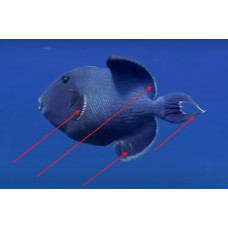The fins are organs of fish movement and regulation of body position in space. The skeleton of the fins consists of cartilaginous or bony rays, between which the swimming membrane is stretched. Rays are solid, non-membered in the form of sharp barbs and articulate, which, in turn, are divided into branched and unbranched. Distinguish paired - pectoral and pelvic and unpaired - dorsal, anal, caudal fins. Paired fins cartilaginous fish - horizontal and serve as bearing surfaces and depth rudders. In most bony fishes paired fins lie in the vertical plane and are organs of inhibition, change of direction and support (kysteperovyh, bipedal). For some fish pectoral fins - the only organ of active movement (rays). The number of unpaired fins varies: for example, in perch - two dorsal fins, some cod - three. In the eel, the dorsal and anal fins imperceptibly pass into the caudal fin, forming a single fin system.
The peripheral parts of the fins are supported by thin rays of horny or bony tissue. In spiny-finned fish, the anterior of these rays thicken and form hard barbs, sometimes associated with venom glands. To the base of these rays are attached muscles that stretch the fin blade. Dorsal and anal fins serve to regulate the direction of movement of fish, but sometimes they can be and organs of forward motion or perform additional functions (such as attracting prey). The caudal fin, which varies greatly in shape in different fish, is the main organ of movement.
In the process of vertebrate evolution, the fins of fish probably arose from a continuous skin fold that ran along the back of the animal, wrapped around the rear end of its body and continued on the ventral side to the posterior aperture, then divided into two lateral folds that continued to the gill slits; this is the position of the fin folds in the modern primitive chordate, Lancetnus. It can be assumed that in the process of animal evolution in some places of such folds skeletal elements were formed and in the intervals the folds disappeared, which led to the emergence of unpaired fins in roundworms and fishes and paired fins in fishes. In favor of this is the presence of lateral folds or venom spines in the oldest vertebrates (some jawless, acanthodia) and the fact that in modern fish paired fins have a greater length in the early stages of development than in the adult state. Among amphibians, unpaired fins in the form of a skin fold devoid of skeleton are present as permanent or temporary formations in most larvae living in water, as well as in adult caudate and larvae of tailless amphibians. Among mammals, fins are present in cetaceans and sirenians that have transitioned to an aquatic lifestyle. The unpaired fins of cetaceans (vertical dorsal and horizontal caudal) and lilacs (horizontal caudal) have no skeleton; they are secondary formations, not homologous to the unpaired fins of fish. The paired fins of cetaceans and lilacs, represented only by the anterior fins (the posterior fins are reduced), have an internal skeleton and are homologous to the forelimbs of all other vertebrates.
Fins
Tags: fins

